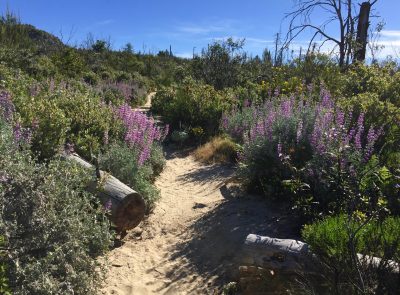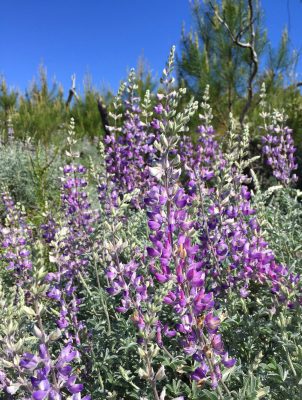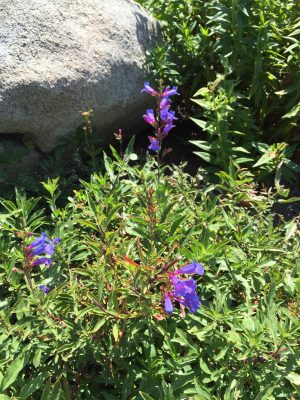I?ve hiked the trails of the Bonny Doon Ecological Reserve for many years, even before the 2008 Martin Fire. Since then we?ve had wet and dry winters but I was amazed at the amount of regrowth this year when I visited recently. The trees are getting huge, the shrubs robust and the flowering perennials took my breath away.

Everything is green and lush now around our homes and wild areas but summer is right around the corner and with it comes the increased danger of fire. What should we be doing to keep our homes safe? Is there a landscape that is safer in a wildfire than another? Which plants burn more readily?
Fire safe landscaping is a term used to describe defensible space. It can look like a traditional landscape. The idea is to surround the home with things less likely to burn and place them to provide separation between canopies and avoid creating fire ladders. Highly flammable plants should be placed, whenever possible, with low-growing and/or low fuel plants.
The three basic rules that Cal Fire advocates to make your home and community safe are to remove dead vegetation, thin out live vegetation and prune up your trees within 100 feet of your home or at least to your property line. There are guidelines for each area within that 100 feet but that?s a good rule of thumb to follow.

Your landscaping should be well-spaced, watered appropriately and the plants fire resistant. Plants should be low enough around the home that if they do catch fire they won’t give the flames a ladder to the eaves of a structure or lower branches of trees. Replace flammable plants with fire-resistant plants. Fire-resistant plants have watery sap, little flammable material and open, airy growth. Plants that provide fruit or flowers for bouquets are usually fire-resistant.
Even green plants will burn and several such as rosemary, lavender, large ornamental grasses, Japanese honeysuckle and juniper are actually extremely flammable. Some drought tolerant and native plants like sagebrush, baccharis, toyon, deer grass and buckwheat contain large amount of pitch, resin and dry flammable twiggy material. Keep these low and full of fresh green growth with frequent trimming. Remove dead limbs and twigs from manzanita. If you have these plants on your property yearly pruning and maintenance is important.
Prune pine, cedar, oak and other trees. Thin and separate clumps of brush to reduce their flammability and slow the spread of fire.
Plants with the ability to hold the soil in place and have value for wildlife and their habitat include some drought tolerant, California-friendly, fire resistant plants like western redbud, monkey flower, ceanothus, yarrow, California fuchsia and wild strawberry. Also consider coffeeberry, flowering currant, bush anemone, snowberry, California wax myrtle and evergreen currant. Non-native fire resistant plants from areas include rockrose, strawberry tree, Chinese pistache, barberry, escallonia, oleander, pittosporum, bush morning glory, dwarf pomegranate and wisteria to name just a few.

Groundcovers for areas closest to your house include ornamental strawberry, red fescue, and sedum. Perennials to try include bush morning glory, coreopsis, fortnight lily, hens and chicks, daylily, penstemon, santolina and society garlic. Vines that resist fire when maintained and watered occasionally include pink jasmine, white potato vine, cape honeysuckle and star jasmine.
Many people think they have to clear everything within 30 feet of their house to truly have a defensible space. This is unnecessary and actually unacceptable due to soil erosion and habitat destruction reasons. We want to retain the character of this beautiful area we live in, provide the food and shelter that our native wildlife are accustomed to but also reduce fire risk.
In areas 30-70 ft. away from your house plants should be trimmed and thinned to create well-spaced groups and help prevent a fire in the wildland from spreading to your home. Be cautious with slopes. If you have a large lot, the fringe area should be inspected and maintained regularly to eliminate any build up of dry brush and litter. This reduces the chance of surface as well as crown fires.
For example, grasslands mowed to leave 4-6″ of height allow insects, reptiles, amphibians, and small mammals shelter, food and a place to reproduce. Leaving 4-6″ standing also provides some erosion protection and shades out some of the weeds that follow disturbance.
All vegetation, including native plants and ornamentals in a residential landscape, is potential wildfire fuel. Vegetation that is properly pruned and maintained, however, can slow a wildfire and reduce the amount of heat around your home.
Irrigation is vital in a fire safe landscape to maintain plant moisture especially within 30 ft around your home. Choose the right irritation system. While all plants can eventually burn, healthy plants burn less quickly. Consider drip irrigation and micro sprays for watering most of your landscape. Use sprinklers and micro spray for lawns and other groundcovers or turf. Even drought adapted species and natives will benefit from watering every month or so during the dry season. Unwatered landscapes generally increase the risk of fire.
Mulching around your plants will preserve the moisture in the soil. Plantings beyond 30 ft. should be irrigated occasionally but to a lesser extent. As you get 70-100 ft from the home, native plantings that require little or no irrigation should be used.
Many homes may not have 30 ft. between their house and the property line but following these guidelines will help. Plants in this area need to be the slowest to ignite and should produce the least amount of heat if they do burn. There are plants with some fire resistance which include drought tolerant California natives and Mediterranean climate selections. The key to fire resistance, though, is maintenance and keeping the moisture in the foliage high.
Plant arrangements, spacing and maintenance are often as important as plant types when considering fire safety. Group plants of similar heights and water requirements to create a landscape mosaic that can slow the spread of fire and use water most efficiently. Use plants that do not accumulate dead leaves or twigs. Keep your landscape healthy and clean. On a regular basis remove dead branches and brush, dry grass, dead leaves and pine needles from your yard, especially within 30 feet from your home and at least 150 ft if you’re on a hill. Keep trees spaced at least 10 feet apart with branches trimmed at least 10 ft away from your roof. It’s best, however, to keep trees further from your house. Low shrubs can be closer in and herbaceous perennials and groundcovers can be nearest the home.
Using fire resistant plants that are strategically planted give firefighters a chance fighting a fire around your home especially within the 100 foot defensible zone. Each home or property is different and you will need to look at the unique qualities of yours in planning your firescaping. Some of the info for this column was obtained from two valuable booklets, ‘Living with Fire in Santa Cruz County’, prepared by Cal Fire and available free from any fire department or online and another booklet published by the Calif. Department of Forestry.
